Two-part Podcast! Hort 2.0—The Future of Our Industry
In episodes 192 and 193 of the Tech On Demand podcast, I asked two of my peers to sit down and discuss the short-term future of our industry. These conversations were recorded live at the 2025 Ball Seed Customer Days open house event in West Chicago, Illinois, which was a lot of fun!
For each episode, I proposed three “big ideas” to my guests—one at a time—to find out what each had to say about them. In both cases, they replied with even bigger ideas and approaches—which I fully expected, and which is also why I picked these specific guests. The goal of this discussion was not to solve all our industry’s challenges in 20 minutes but instead to share ideas for the live audience and our listeners to ponder, and to discuss potential directions in which to steer as our industry enters what I consider a new era.
Since Customer Days is two days, I was able to record one podcast each day in a tent right smack dab in the middle of the spectacular Gardens At Ball. It really was an awesome setting.
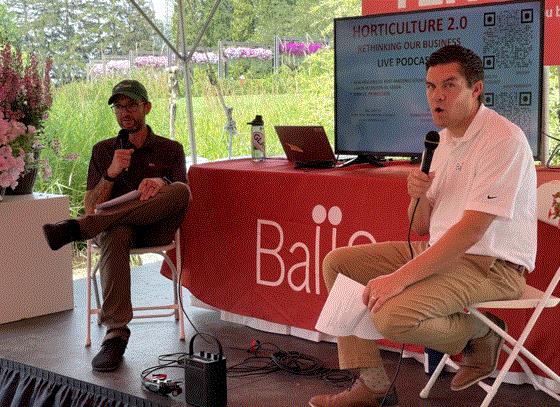 On the first day (Thursday, July 24), my guest was Ball’s Global Sustainability manager Seth Reed. Seth and I have been friends and coworkers for nearly 20 years and always have lively discussions filled with big ideas for the industry. For this one, I tried to focus the ideas on professional growers and ways to innovate for the future of greenhouse production. Seth and I discussed:
On the first day (Thursday, July 24), my guest was Ball’s Global Sustainability manager Seth Reed. Seth and I have been friends and coworkers for nearly 20 years and always have lively discussions filled with big ideas for the industry. For this one, I tried to focus the ideas on professional growers and ways to innovate for the future of greenhouse production. Seth and I discussed:
-
Post-pandemic growth vs. new realities
-
Labor vs. labor retention
-
Production vs. automation
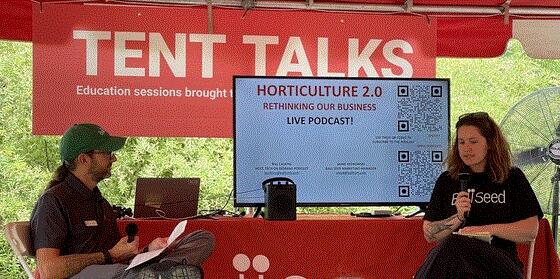
On day 2 (Friday, July 25), I was thrilled when Ball Seed Marketing Manager Jaime Kedrowski agreed to sit down and chat during one of the absolute busiest (and hottest) days of her year. I work closely with Jaime, but I don’t know her nearly as well as I know Seth. But as you’ll hear, we were pretty much in synch right from the start. I respect Jaime’s knowledge of B2B horticultural and agricultural marketing and her ability to blend big ideas with real-world possibilities. Jaime is brilliant and I was excited to pick her brain about ways to level-up our engagement with garden centers and consumers.
You have to listen all the way to the end of the episode because the ideas don’t stop coming until the closing bell. Jaime and I discussed:
-
Horticulture vs. culture
-
New plants vs. new solutions
-
Lifestyle vs. hobby
Be sure to subscribe to the Tech On Demand podcast on your favorite app so you never miss an episode. And if you’re not a regular listener, jump back into the archives and get caught up—there are more than 190 episodes as of today. You can find both Horticulture 2.0 episodes and all the rest on your favorite podcast app, including:
TECH ON DEMAND ON SPOTIFY
TECH ON DEMAND ON APPLE PODCASTS

Koppert Corner: Mealybug Tag Team Takedown
Mealybugs’ reproductive rate is at its peak during the hot and humid dog days of summer. They can be particularly problematic pests for growers with long-term greenhouse crops or shaded production, especially in slow-growing foliage crops. It’s critical to be proactive in preventing their development early in the crop cycle. Start clean, stay clean! If propagation is underway for your 2026 crop or you’re bringing in liners to pot up for next year’s foliage crop, the time for mealybug control is now!
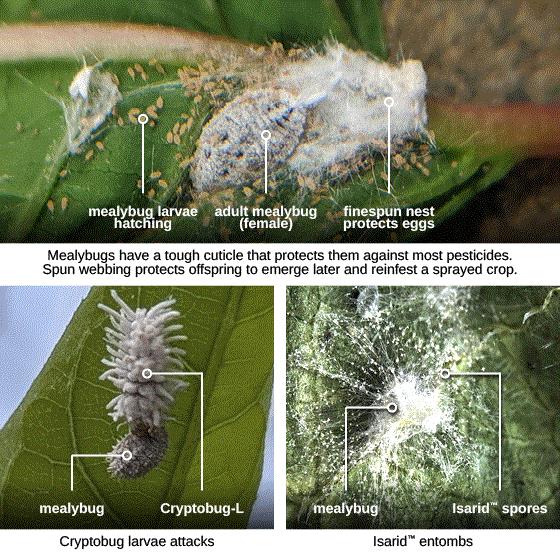
More than 15 mealybug species are found in ornamental production. Since growers are not mealybug taxonomists, we need tools that will kill whatever mealybug species are found in our crops without needing to consult an entomologist.
Isarid is the right tool for this job. Isarid (Isaria fumosorosea, strain FE9901) is a generalist, an equal-opportunity fungus that will infect and kill vulnerable life stages of any mealybug species present as long as viable Isaria spores come in contact with the cuticle of the target insect pest. It is tank-mix compatible with most chemical insecticides and miticides, so it can be added to a chemical IPM program as a non-chemical mode of action. Add a silicon-based adjuvant to improve adhesion and the overall effectiveness of each spray treatment.
Cryptobug-L (Cryptolaemus montrouzieri larvae), or “Crypts” as we call them, are highly effective biological tools against mealybugs. Because they’re shipped in the larval stage (crawlers), Crypt larvae do a great job attacking several species of mealybug typically seen in greenhouse production, particularly when released onto active colonies of mealybug adult females and immatures. Without wings, they remain on the job site where they’re released; however, it can take time for them to find all the mealybug hot spots, especially in tall crops or those with a large canopy, and regular weekly releases are needed for consistent results.
In comes Isarid, which is compatible with and works perfectly in tandem with Cryptobug-L by infecting the mealybug eggs and nymphs which the Crypts may not have reached. Weekly Isarid sprays ensure that as immatures emerge from web-encased, protective egg clusters or from under momma mealybug, they’re vulnerable to infection by Isaria spores (unless a Crypt gets to them first).
Reach out to the Koppert Technical Consultant in your area to learn more about utilizing these effective biological tools to achieve long-term mealybug control and prevention in fall propagation.

Josh’s Guest Tip of the Week: Root-Zone Management in Outdoor Container Crops
Usually you hear from my buddy Nick Flax, a technical services expert at Ball, in this space. But sometimes Josh Henry jumps in with a tech tip, and that’s the case this week. With so many container crops in production this time of year, Josh wanted to discuss keeping roots heathy when the weather is unpredictable.
PROBLEM: Field-grown container crops, including garden mums and fall container programs, are subject to fluctuating weather conditions such as temperature and precipitation extremes, making rootzone management especially critical for these crops. Excessive rainfall, nutrient leaching and disease pressure can cause plant stress, poor growth and crop losses.
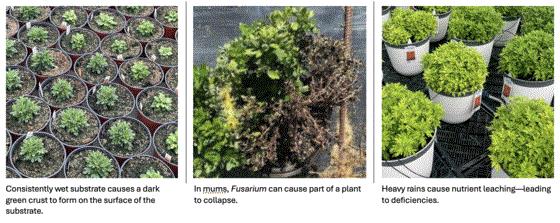
JOSH’S TIP: When it comes to understanding the rootzone environment, remember: soilless substrates must balance the ratio of solid components (e.g., peat, perlite, bark) with air- and water-filled pore spaces—ideally around 50% solids, 25% air and 25% water.
Containers grown in the field are subject to adverse weather conditions, which can fluctuate throughout the growing season. Heavy summer rains are a major concern for growers, as they can leach nutrients and reduce the air-filled pore spaces, stressing the plants and making conditions more favorable for root rot pathogens to cause disease.
A proactive approach focused on maintaining healthy roots through disease prevention and irrigation and fertility management is your key to success. Here are three important processes to implement:
Stay Ahead of Root Diseases
-
Wet, saturated conditions are conducive to root and crown rot pathogens—causing disease. Watch for low spots and improve field drainage.
-
Develop a comprehensive fungicide drench rotation covering major pathogens like Pythium, Phytophthora and Fusarium. Utilize labeled fungicides, including strobilurins, thiophanate-methyl and etridiazole.
-
Incorporate biological options that support root health. Some species of Trichoderma and Streptomyces are effective.
Manage Fertility with the Weather in Mind
Heavy rain can rapidly leach nutrients, leading to deficiencies. Fertilizing immediately after rain replaces low-EC rainwater with essential nutrients.
Consider a combination of controlled-release fertilizer (CRF) and water-soluble fertilizer (WSF) for consistent fertility. Incorporate a low to medium rate of CRF as a base to buffer against leaching and use WSF for quick corrections and flexibility. Note: Be sure to monitor EC and pH regularly to help make fertility decisions.
Avoid Irrigation Extremes
-
Water based on crop needs and weather, not based on a timer. Check moisture using the 1–5 scale or by weight and let pots dry slightly between waterings to promote deeper rooting. Aim for a 15% leaching fraction (LF).
-
Reduce irrigation after rain to prevent excess saturation, and consider the forecast to decide if watering is necessary.
-
Prioritize morning irrigations to reduce wet foliage and humid microclimates in the canopy.

Tracking Poinsettia Growth (and DIF)
As your poinsettia crop progress toward the glorious moment when it ships out of your greenhouse, graphical tracking to hit retail specs and adjusting accordingly becomes more and more important. Fine-tuning height and width can be achieved a couple different ways, and that’s the topic covered by Michigan State Professor Emeritus and respected greenhouse production guru Dr. Royal Heins in a Grow Pro webinar produced by our friends at the American Floral Endowment (AFE).
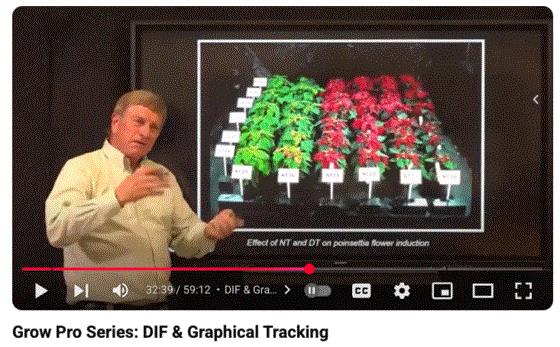
Watch DIF & GRAPHICAL TRACKING to learn how precision control of poinsettia height can be accomplished with plant growth regulators or altering the day and night temperatures during crop development or a combination of both methods. Dr. Heins provided guidance in use of day/night temperature to control height and graphical tracking to guide the temperature changes necessary throughout the crop.
When you’re done with this video, scroll through UPCOMING GROW PRO WEBINARS and the archive to find dozens more videos presented by leading researchers and technical experts covering a huge range of topics for professional growers. AFE is an awesome resource, and their content is always top-notch.

Cool New Stuff at Cultivate—A Video
I meant to include this last week—in fact it was in my content plan, but instead I shared the Ball Seed Customer Days video … Better late than never.
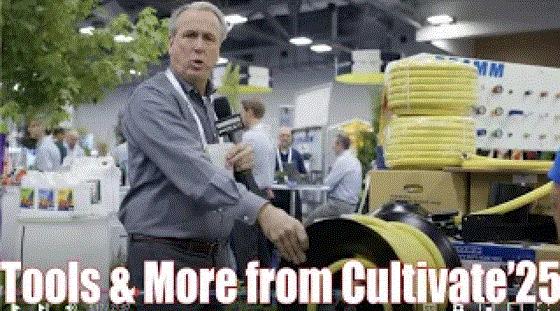
Join GrowerTalks editor-in-chief (aka bossman) Chris Beytes as he roams the show floor looking for exciting new products at AmericanHort’s Cultivate'25 trade show.
What did he find? YOU’LL HAVE TO WATCH! Some of the cool innovations included low-cost tools, high-tech labor-savers and the favorite plants of the Retailers' Choice Awards judges.
Finish Line …
The August issue of GrowerTalks and Green Profit is probably on your desk. If you prefer to peruse it digitally, that’s cool—it’s online for your enjoyment.
Maybe you’ve already flipped through or maybe that’s your rainy day activity. I just wanted to call your attention to a special section in GrowerTalks that’s focused on perennial production. Successfully overwintering perennials is in the spotlight and six articles written by six leading perennial experts tackle the topic from all angles.
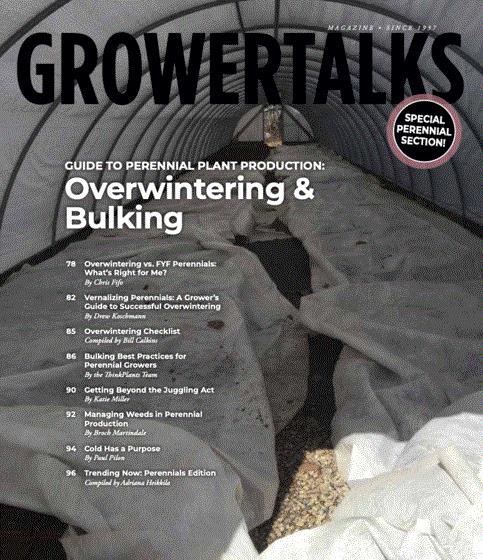
You can find the 21-page GUIDE TO PERENNIAL PLANT PRODUCTION: OVERWINTERING & BULKING starting on page 77 of the magazine or by clicking the link (because we posted it online as a standalone piece).
From choosing which crops to overwinter (versus grow as first-year-flowering) and successful vernalization to bulking best practices and the purpose of cold treatment vis-à-vis plant quality, this special section is really a crash course to help you optimize your perennial production. Other topics covered included managing weeds in perennial production (across multiple seasons) and using perennials for early-season color. We also included a handy overwintering checklist and “trending now” feature with new products to consider.
Big shout out to the contributing authors and supporting companies that helped make this guide possible. And watch for another one—covering a different perennial-focused topic—next spring!
Talk to you next week …




Please feel free to send your comments, constructive criticism and topic ideas to me at bcalkins@ballhort.com.

Bill Calkins
Editor - Tech On Demand
This email was received by you and 25,538 other fine subscribers!
If you're interested in advertising in Tech On Demand, contact Kim Brown ASAP and she'll hook you up.